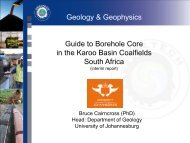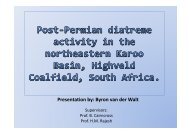coaltech upper olifants river catchment wetland inventory ...
coaltech upper olifants river catchment wetland inventory ...
coaltech upper olifants river catchment wetland inventory ...
Create successful ePaper yourself
Turn your PDF publications into a flip-book with our unique Google optimized e-Paper software.
In a <strong>wetland</strong> assessment conducted as part of a proposed new extension of the Elders Strip<br />
and Underground Mine (1), the status of the <strong>wetland</strong>s on the property was investigated<br />
(Marneweck 2003). The investigated area is located to the north of Bethal. The current status<br />
of the <strong>wetland</strong>s differs from the historical status of the <strong>wetland</strong>s due to impacts of agriculture,<br />
as well as, the road and railway infrastructure. The <strong>wetland</strong>s in the area are not in a pristine<br />
condition, but can be considered to be in a relatively natural state. There are however,<br />
sections of the <strong>wetland</strong>s that have been disturbed, with some erosion taking place on some<br />
portions, and signs of overgrazing, and poor water quality due to discharges in portions of<br />
the <strong>wetland</strong>. Another disturbance is the farm dams located in the drainage channel.<br />
Cultivation practices have mostly taken place outside the floodplains, pans and riparian<br />
areas, but seepage areas have been lost due to cultivation. Agricultural practices in the area<br />
had an indirect impact on all of the pans, through cultivation, damming, water abstraction, or<br />
other activities (Marneweck 2003).<br />
The assessments on the aquatic ecosystems at the Elders Strip and Underground Mine (1),<br />
focussing on SASS and fish also concluded that the <strong>wetland</strong> system was moderately<br />
modified to largely natural (Palmer and Engelbrecht 2003). The species from the assessment<br />
are included in the species lists (Addendums to this report).<br />
Several of the <strong>wetland</strong>s in the Goedehoop Colliery (2) area have been impacted on by<br />
various activities, mainly damming. Agricultural practices also have an impact on the<br />
<strong>wetland</strong>s by reducing water into the <strong>wetland</strong> systems. Water is extracted from the dams to<br />
irrigate crops and water livestock, thereby reducing the flow in the streams. Several alien<br />
species also occur in the <strong>wetland</strong>s, indicating disturbed conditions (De Lange et al 2003).<br />
In a study conducted on Goedgevonden to the south of Ogies (2) seven <strong>wetland</strong> types were<br />
identified (Marneweck 2004a, Wetland Consulting Services 2005):<br />
o Valley bottom <strong>wetland</strong>s with channels;<br />
o Valley bottom <strong>wetland</strong>s without channels;<br />
o Hillslope seepage connected to watercourses;<br />
o Isolated hillslope seepage;<br />
o Hillslope seepage connected to pans;<br />
o Pans; and<br />
o Mined <strong>wetland</strong>s.<br />
Most of the <strong>wetland</strong>s in the area have been moderately to critically modified (Marneweck<br />
2004a, Wetland Consulting Services 2005).<br />
Wetland Database for UORC - 65 -




